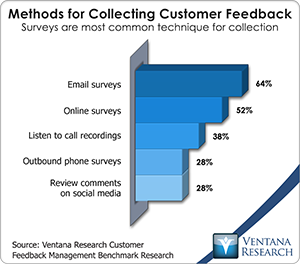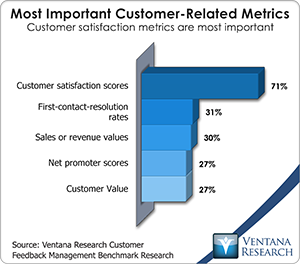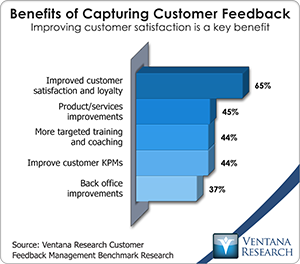Many organizations collect customer feedback, but my recent research into customer feedback management shows that most have yet to take advantage of modern techniques. The research shows that companies on average use approximately four methods. The most popular remain email and online surveys, listening to call recordings and outbound phone calls. Newer techniques such as reviewing social media posts, social media forums, mobile apps and mobile text-based conversations remain the domain of early adopters and innovative companies. The same can be said of how companies analyze customer feedback, with by far the most common method being manual. Only the most mature companies having adopted specialized analytics tools that automate the process, thus making it more efficient, letting them use bigger samples of customer input, and making the outputs more reliable and consistent.
shows that companies on average use approximately four methods. The most popular remain email and online surveys, listening to call recordings and outbound phone calls. Newer techniques such as reviewing social media posts, social media forums, mobile apps and mobile text-based conversations remain the domain of early adopters and innovative companies. The same can be said of how companies analyze customer feedback, with by far the most common method being manual. Only the most mature companies having adopted specialized analytics tools that automate the process, thus making it more efficient, letting them use bigger samples of customer input, and making the outputs more reliable and consistent.
This reluctance to change is reflected in the metrics organizations use to assess the success of their customer-facing activities.  Surprisingly the research shows that companies rely on average on just two metrics, and by far the most common remains customer satisfaction scores. This metric has topped the list for the last nine years I have carried out research into customer and contact management performance. Despite organizations inventing new metrics on a regular basis, customer satisfaction is still twice as important to any other metric.
Surprisingly the research shows that companies rely on average on just two metrics, and by far the most common remains customer satisfaction scores. This metric has topped the list for the last nine years I have carried out research into customer and contact management performance. Despite organizations inventing new metrics on a regular basis, customer satisfaction is still twice as important to any other metric.
The challenge with customer satisfaction is how to reliably measure it, and doing so consistently across lines of business and communication channels. Customer satisfaction also doesn’t specifically relate to any outcomes, so it is hard to tie it to business success; most organizations rely on their “gut feel” that more satisfied customers deliver more business benefits.
The first-contact resolution rate metric has risen in popularity over the same period. It does relate to business outcomes: higher first-contact resolution rates mean fewer call-backs, which means lower costs. This also relates to customer satisfaction, since most customers would rather get an answer right away and not have to wait for someone to get back to them, especially given that often no one does follow up.
The research shows that organizations that have deployed customer feedback have in nearly two-thirds of cases seen customer satisfaction and loyalty increase. In today’s competitive markets, in which it is difficult to attract new customers, customer loyalty is increasingly important. Retaining loyal customers also opens up the opportunity to increase up-sales to those customers; however, as my research into customer experience management shows, this does require companies have specific plans in place to make this opportunity a reality – for example, special marketing programs, sales offers and personalized customer experiences that make best use of up-sale opportunities during every interaction. In addition to improving customer satisfaction and loyalty, companies have been able to improve products and services based on customer feedback, focus training and coaching for their front-line customer-facing staff, and improve key customer-related metrics. Training and coaching of front-line staff takes considerable time and effort for most organizations, so using customer feedback to make these tasks more personalized and focus them on individual needs can not only lower direct costs but also result in happier staff (leading to reduced turnover), which leads to improved customer experiences, which again has a positive impact on customer satisfaction.
the opportunity to increase up-sales to those customers; however, as my research into customer experience management shows, this does require companies have specific plans in place to make this opportunity a reality – for example, special marketing programs, sales offers and personalized customer experiences that make best use of up-sale opportunities during every interaction. In addition to improving customer satisfaction and loyalty, companies have been able to improve products and services based on customer feedback, focus training and coaching for their front-line customer-facing staff, and improve key customer-related metrics. Training and coaching of front-line staff takes considerable time and effort for most organizations, so using customer feedback to make these tasks more personalized and focus them on individual needs can not only lower direct costs but also result in happier staff (leading to reduced turnover), which leads to improved customer experiences, which again has a positive impact on customer satisfaction.
Today customer feedback is linked closely with voice-of-the-customer programs. In my experience these program often have a narrow focus and often focus on one key metric, which increasingly is net promoter scores. I believe that by looking at the wider picture and learning from the benefits other organizations have achieved, companies can make the case for expanding the channels through which they collect customer feedback and automating the process by using some of the newer analytics tools now available. Those that do so successfully will drive better business outcomes.
Regards,
Richard J. Snow
VP & Research Director












